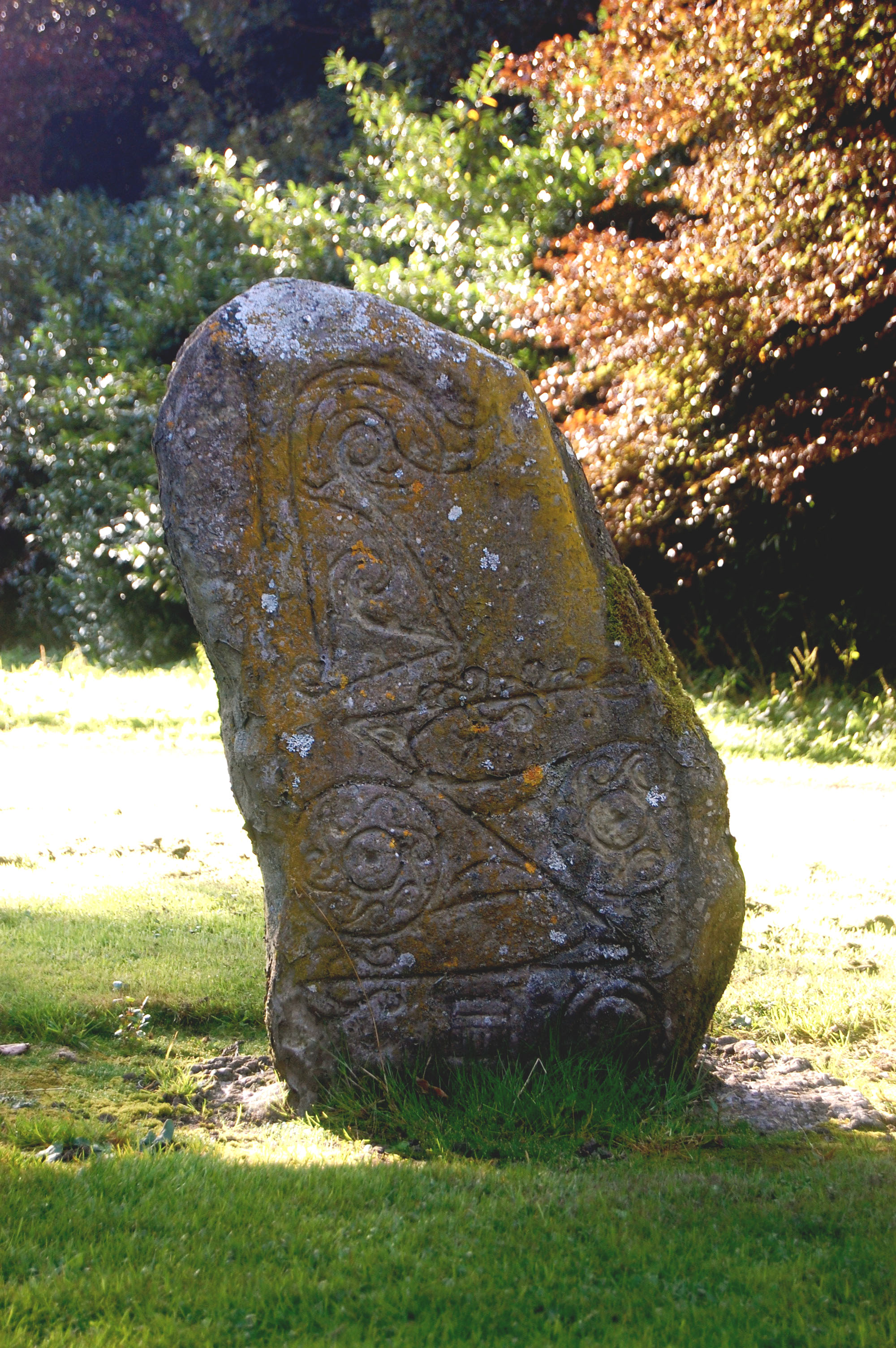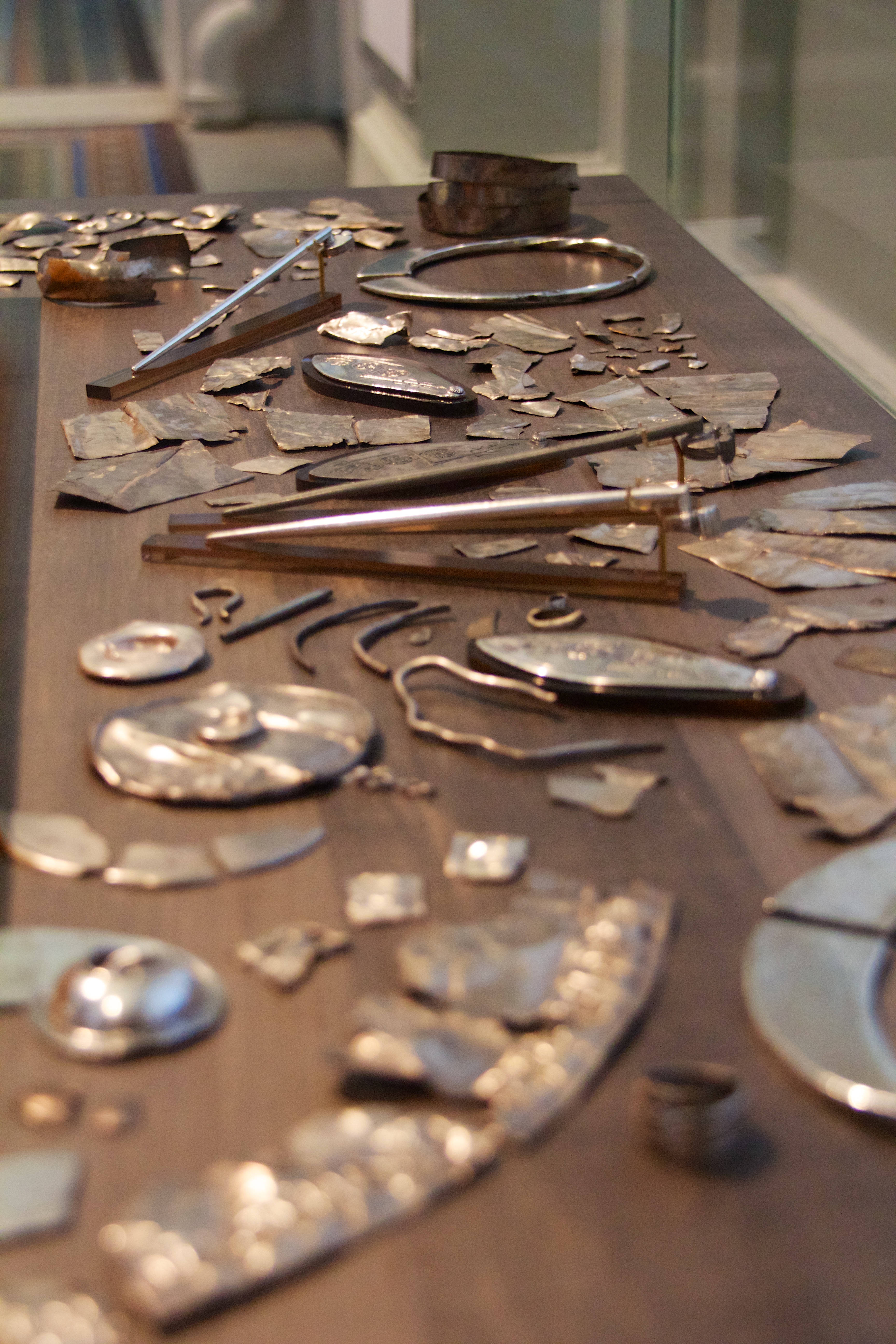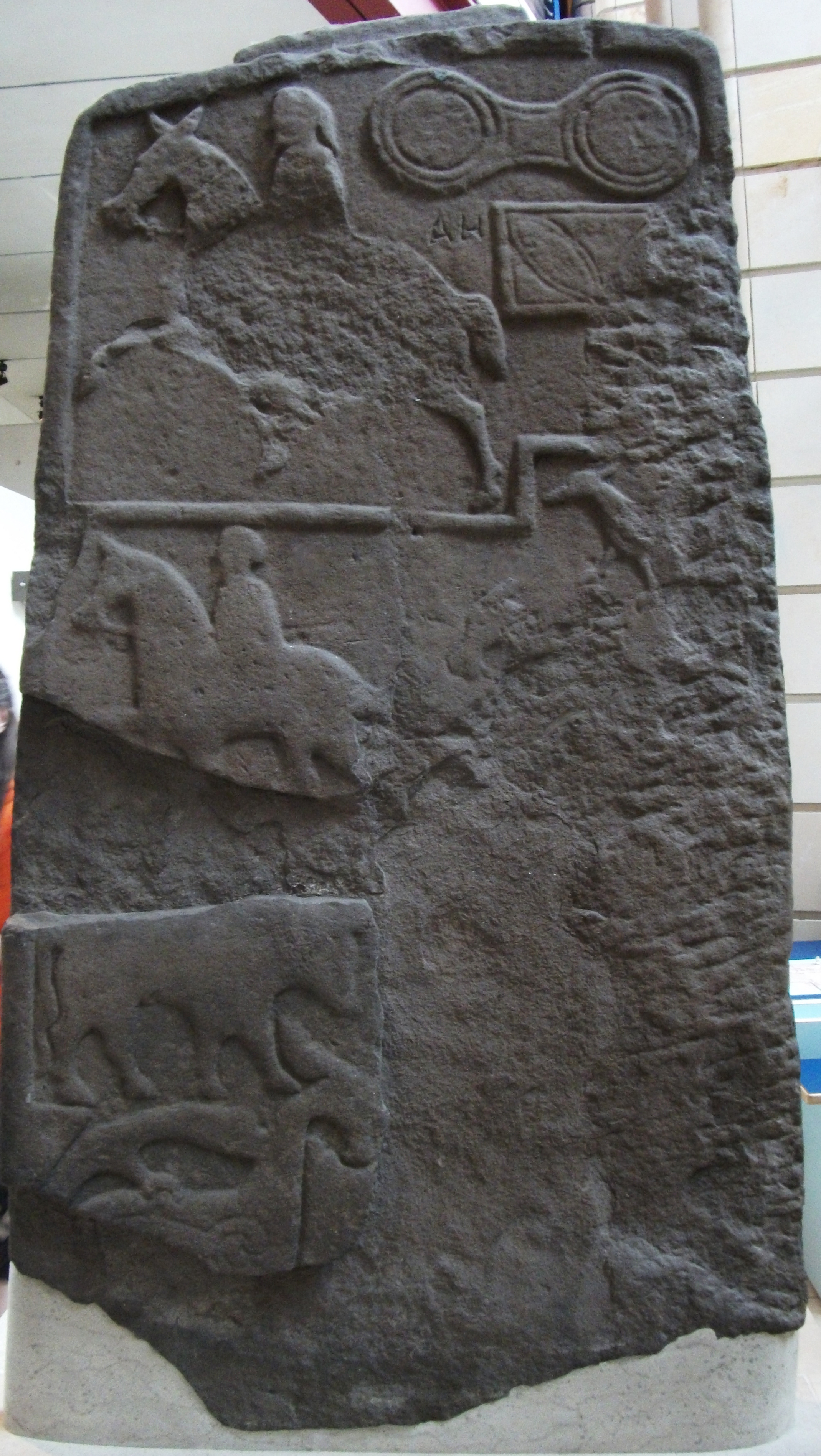|
Double Disc (Pictish Symbol)
The double disc is a Pictish symbol of unknown meaning that is frequently found on Class I and Class II Pictish stones, as well as on Pictish metalwork. The symbol can be found with and without an overlaid ''Z-rod'' (also of unknown meaning), and in combinations of both (as with the Monifieth 1 stone). Gallery File:Serpent stone.JPG, Aberlemno 1; Class I stone with double disc and Z rod File:DunnichenMeffan.jpg, Dunnichen Stone; Class I with double disc and Z rod File:Aberlemno III symbols.jpg, Aberlemno 3 rear face detail; Class II File:Monifieth1 rear.jpg, Monifieth 1; Class II stone with double discs with and without Z-rod File:Whitecleuch chain detail.jpg, Detail of penannular ring on Whitecleuch Chain showing double disc and Z-rod File:Norrie's LawDSCF6226.jpg, Plaque from Norrie's Law Norrie's Law hoard is a sixth century silver hoard discovered in 1819 at a small mound in Largo, Fife, Scotland. Found by an unknown person or persons, most of the hoard was illegally ... [...More Info...] [...Related Items...] OR: [Wikipedia] [Google] [Baidu] |
Picts
The Picts were a group of peoples who lived in what is now northern and eastern Scotland (north of the Firth of Forth) during Late Antiquity and the Early Middle Ages. Where they lived and what their culture was like can be inferred from early medieval texts and Pictish stones. Their Latin name, , appears in written records from the 3rd to the 10th century. Early medieval sources report the existence of a distinct Pictish language, which today is believed to have been an Insular Celtic language, closely related to the Common Brittonic, Brittonic spoken by the Celtic Britons, Britons who lived to the south. Picts are assumed to have been the descendants of the Caledonians, Caledonii and other British Iron Age, Iron Age tribes that were mentioned by Roman historians or on the Ptolemy's world map, world map of Ptolemy. The Pictish kingdom, often called Pictland in modern sources, achieved a large degree of political unity in the late 7th and early 8th centuries through the expa ... [...More Info...] [...Related Items...] OR: [Wikipedia] [Google] [Baidu] |
Pictish Stones
A Pictish stone is a type of monumental stele, generally carved or incised with symbols or designs. A few have ogham inscriptions. Located in Scotland, mostly north of the Clyde-Forth line and on the Eastern side of the country, these stones are the most visible remaining evidence of the Picts and are thought to date from the 6th to 9th century, a period during which the Picts became Christianized. The earlier stones have no parallels from the rest of the British Isles, but the later forms are variations within a wider Insular tradition of monumental stones such as high crosses. About 350 objects classified as Pictish stones have survived, the earlier examples of which holding by far the greatest number of surviving examples of the mysterious symbols, which have long intrigued scholars. ... [...More Info...] [...Related Items...] OR: [Wikipedia] [Google] [Baidu] |
Monifieth Sculptured Stones
The Monifieth Sculptured Stones are a series of five class II and III standing Pictish stones from the early Medieval period found in or around St Regulus' church in Monifieth, Angus, Scotland. Uncovered during the demolition of a pre-Reformation church and its kirkyard wall in the 19th and 20th centuries, the stones are now housed in the collection of the Museum of Scotland. Location Stones located at St Regulus' (St Rule's) Church, Monifieth, Angus, Scotland () until 1870 (the stones known as Monifieth 1, 2, 3 and 4) or 1928 (Monifieth 5). Monifieth 4 was possibly originally located at St Bride's Ring, Kingennie () and moved to Monifieth in pre-Reformation times. All five are now housed in the collection of the Museum of Scotland, Edinburgh (). History The church and lands of Monifieth were originally possessions of the ascetic Céli Dé monastic order. The church was endowed to the recently founded Arbroath Abbey by Gille Críst, Earl of Angus around 1201–1207, and the ... [...More Info...] [...Related Items...] OR: [Wikipedia] [Google] [Baidu] |
Aberlemno Sculptured Stones
The Aberlemno Sculptured Stones are a series of five Class I and II Early Medieval standing stones found in and around the village of Aberlemno, Angus, Scotland. Location Aberlemno 1, 3 and 5 are located in recesses in the dry stone wall at the side of the road in Aberlemno (). Aberlemno 2 is found in the Kirkyard, 300 yards south of the roadside stones.() In recent years, bids have been made to move the stones to an indoor location to protect them from weathering, but this has met with local resistance and the stones are currently covered in the winter. The stones are covered with wooden boxes from the last working day of September until the first working day of April. Aberlemno 4, the Flemington Farm Stone was found 30 yards from the church (), and is now on display in the McManus Galleries, Dundee. Description Aberlemno 1 Aberlemno 1 is the central roadside stone. It is an unshaped standing stone, bearing incised Pictish symbols, defining it under J Romilly Allen and ... [...More Info...] [...Related Items...] OR: [Wikipedia] [Google] [Baidu] |
Dunnichen Stone
The Dunnichen Stone is a class I Pictish symbol stone that was discovered in 1811 at Dunnichen, Angus. It probably dates to the 7th century AD. Location The exact location at which the stone was found is unknown, but thought to be in a field in the East Mains of Dunnichen, on the SE slope of Dunnichen Hill, (), overlooking Dunnichen Moss. It is currently on display at the Meffan Institute in Forfar (). History Jervise relates that the stone was found in a field called the ''Chashel'' or Castle Park, and that the site later became a quarry A quarry is a type of open-pit mine in which dimension stone, rock, construction aggregate, riprap, sand, gravel, or slate is excavated from the ground. The operation of quarries is regulated in some jurisdictions to reduce their envir .... While this name is no longer extant, Headrick records that it was in East Mains of Dunnichen, and the location was later assigned in 1966 at a disused quarry on that farm. The discovery was ... [...More Info...] [...Related Items...] OR: [Wikipedia] [Google] [Baidu] |
Whitecleuch Chain
The Whitecleuch Chain is a large Picts, Pictish silver chain that was found in Whitecleuch, Lanarkshire, Scotland in 1869. A high status piece, it is likely to have been worn as a choker neck ornament for ceremonial purposes. It dates from around 400 to 800 AD. The chain is one of ten certain examples of this type, and is on display at the Museum of Scotland in Edinburgh. Description Weighing 1.8 kg and measuring approximately 50 cm in length, the chain consists of 44 silver rings interlinked into 22 pairs. According to Clark, the chain originally had 23 pairs of rings, but was damaged subsequent to its discovery. The paired ring chain is joined by a large Penannular ring, penannular piece with expanded flanges. The penannular ring bears Pictish stone#Purpose and meaning, Pictish symbols of the sort typically found on Class I and II Pictish stones, Pictish standing stones. On one side of the opening in the ring, there is a zigzag pattern and a Double disc (Pictish symb ... [...More Info...] [...Related Items...] OR: [Wikipedia] [Google] [Baidu] |
Norrie's Law
Norrie's Law hoard is a sixth century silver hoard discovered in 1819 at a small mound in Largo, Fife, Scotland. Found by an unknown person or persons, most of the hoard was illegally sold or given away. Remaining items of the hoard were found later at the mound, and were turned over to the landowner, General Philip Durham. The surviving 170-piece hoard now is in the National Museum of Scotland. The treasure consists mostly of hacksilver and includes four complete silver pieces. Description Norrie's Law hoard is one of the largest Pictish hoards ever to be found. The hoard originally contained of late Roman and Pictish silver. Less than of the hoard remains. Consisting of 170 pieces of primarily hacksilver, the treasure also contains complete silver metalwork, including a penanular brooch, a leaf-shaped oval plaque with Pictish symbols, a large hand-pin, and a worn spiral finger-ring. Incomplete items include part of a Roman spoon, pieces of silver sheet from a plate and i ... [...More Info...] [...Related Items...] OR: [Wikipedia] [Google] [Baidu] |
St Orland's Stone
St Orland's Stone (otherwise known as the Cossans stone or the Cossins stone) is a Class II Pictish Cross-Slab at Cossans, near Kirriemuir and Forfar, Angus, Scotland Location The cross-slab stands in situ, approximately south-west of the A926 road at its midpoint between Kirriemuir and Forfar () in the former parish of Glamis. Description The stone is a worked slab of Old Red Sandstone, tall wide and wide. The slab is carved on both faces in relief and, as it bears Pictish symbols, it falls into John Romilly Allen and Joseph Anderson's classification system as a class II stone. The cross face bears a ringed Celtic cross decorated with interlaced knotwork and spiral designs. It is surrounded in the lower two quadrants by interlaced fantastic beasts. The border appears to have once borne knotwork designs, but is weathered and difficult to interpret. The rear face is bears crescent and v-rod and double disc and z-rod Pictish symbols. Below this is what appears to be a hun ... [...More Info...] [...Related Items...] OR: [Wikipedia] [Google] [Baidu] |
Invereen Stone
The Invereen Stone is a Class I incised Pictish stone that was unearthed near Invereen, Inverness in 1932. It is now on display at the National Museums of Scotland, Edinburgh Edinburgh ( ; gd, Dùn Èideann ) is the capital city of Scotland and one of its 32 Council areas of Scotland, council areas. Historically part of the county of Midlothian (interchangeably Edinburghshire before 1921), it is located in Lothian ..., Scotland. Description The stone is of light red sandstone, high, wide and deep. It was unearthed in 1932 by a Mr. A. Dunbar near Invereen () while ploughing. The stone bears a crescent and v-rod symbol and a double disc and z-rod, with a third design of a circle and line, possibly being later in date. References {{coord, 57.3545, N, 4.0011, W, type:landmark_region:GB, display=title Pictish stones ... [...More Info...] [...Related Items...] OR: [Wikipedia] [Google] [Baidu] |
Woodwrae Stone
The Woodwrae Stone (alternatively the Woodwray Stone) is a Class II Pictish Stone (c. 8th or 9th century) that was found in 1819 when the foundations of the old castle at Woodwrae, Angus, Scotland were cleared. It had been reused as a floor slab in the kitchen of the castle. Following its removal from the castle, it was donated to the collection of Sir Walter Scott at Abbotsford House. It is now on display at the Museum of Scotland in Edinburgh. Location Woodwrae castle occupied a position north of Aberlemno, Angus , now occupied by Woodwrae farm. The stone was used as a floor slab at the castle and was removed in 1819 to the collection of Sir Walter Scott at Abbotsford House where it resided until it was donated to the Society of Antiquaries of Scotland in 1924. Description The stone is a cross-slab high and wide, tapering to at the top, and is thick. The slab is carved on both faces in relief and, as it bears Pictish symbols, it falls into John Romilly Allen and Joseph A ... [...More Info...] [...Related Items...] OR: [Wikipedia] [Google] [Baidu] |






